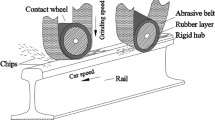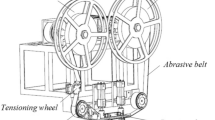Abstract
In order to establish a theoretical foundation of rail profile reshaping through belt grinding with a concave contact wheel, the static contact behavior between the contact wheel and railhead is preliminarily modeled and investigated. The geometry interference between wheel and rail profile under certain contact conditions is initially analyzed. Based on the integral method, 3D contact problem is then analyzed through transferring it as a series of 2D issues between a thin elastic sheet surrounded by a rigid circle base and a rigid plan, from which the boundary curve function and the stresses distribution of contact zone are developed. Results from both finite element simulations and real contact experiment have validated the availability of qualitative analysis and quantitative prediction of the proposed model. Results from model and validation have agreed that the contact zone shape should be classified into three types due to different contact conditions, namely the ellipse, the triangle, and the saddle-shape.
Similar content being viewed by others
References
Zhi S, Li J, Zarembski AM (2016) Predictive modeling of the rail grinding process using a distributed cutting grain approach. P I Mech Eng F-J Rai 230(6):1540–1560
Liu Y, Yang T, He Z, Li J (2018) Analytical modeling of grinding process in rail profile correction considering grinding pattern. Arch Civ Mech Eng 18(2):669–678
Zhi S, Li J, Zarembski AM (2015) Grinding motor energy saving method based on material removal model in rail grinding processes. Int J Pr Eng Man-GT 2(1):21–30
Steenbergen M (2016) Rolling contact fatigue in relation to rail grinding. Wear 356–357:110–121
Ding W, Dai C, Yu T, Xu J, Fu Y (2017) Grinding performance of textured monolayer CBN wheels: undeformed chip thickness nonuniformity modeling and ground surface topography prediction. Int J Mach Tool Manu 122:66–80
Dai CW, Ding W, Zhu Y, Xu J, Yu H (2018) Grinding temperature and power consumption in high speed grinding of Inconel 718 nickel-based superalloy with a vitrified CBN wheel. Precis Eng 52:192–200
Liu C, Ding W, Yu T, Yang C (2018) Materials removal mechanism in high-speed grinding of particulate reinforced titanium matrix composites. Precis Eng 51:68–77
Khellouki A, Rech J, Zahouani H (2007) The effect of abrasive grain’s wear and contact conditions on surface texture in belt finishing. Wear 263(1–6):81–87
Khellouki A, Rech J, Zahouani H (2007) Influence of the belt-finishing process on the surface texture obtained by hard turning. P I Mech Eng B-J Eng 221(7):1129–1137
Zhang X, Kuhlenkötter B, Kneupner K (2005) An efficient method for solving the Signorini problem in the simulation of free-form surfaces produced by belt grinding. Int J Mach Tool Manu 45(6):641–648
Zhang X, Kneupner K, Kuhlenkötter B (2006) A new force distribution calculation model for high-quality production processes. Int J Adv Manuf Technol 27(7–8):726–732
Ren X, Kuhlenkötter B, Müller H (2006) Simulation and verification of belt grinding with industrial robots. Int J Mach Tool Manu 46(7–8):708–716
Ren X, Cabaravdic M, Zhang X, Kuhlenkötter B (2007) A local process model for simulation of robotic belt grinding. Int J Mach Tool Manu 47(6):962–970
Ren X, Kuhlenkötter B (2008) Real-time simulation and visualization of robotic belt grinding processes. Int J Adv Manuf Technol 35(11–12):1090–1099
He Z, Li J, Liu Y, Nie M, Fan W (2017) Investigating the effects of contact pressure on rail material abrasive belt grinding performance. Int J Adv Manuf Technol 93(1–4):779–786
Wang W, Liu F, Liu Z, Yun C (2017) Prediction of depth of cut for robotic belt grinding. Int J Adv Manuf Technol 91(1–4):699–708
Wang Y, Huang Y, Chen Y, Yang Z (2016) Model of an abrasive belt grinding surface removal contour and its application. Int J Adv Manuf Technol 82(9–12):2113–2122
Sun Y, Vu T, Halil Z, Yeo S (2017) Pressure distribution of serrated contact wheels—experimental and numerical analysis. Int J Adv Manuf Technol 90(9–12):3407–3419
Zhou Q, Zhang Y, Tian C, Chen Z, Liu F, Yu Z, Li L (2014) Profile design and test study of 60N rail. Zhongguo Tiedao Kexue 35(2):128–135 (Chinese)
Popov VL (2010) Contact mechanics and friction, 1st edn. Springer Berlin Heidelberg, Berlin
Acknowledgments
The authors are grateful to Dr. Rafal Kaminski and Dr. Vipul Vijigiri for the help in improving the English text of the paper.
Funding
This work was supported by the Fundamental Research Funds for the Central Universities (grant number 2017JBM043).
Author information
Authors and Affiliations
Corresponding author
Rights and permissions
About this article
Cite this article
Wang, W., Li, J. & Fan, W. Investigation into static contact behavior in belt rail grinding using a concave contact wheel. Int J Adv Manuf Technol 101, 2825–2835 (2019). https://doi.org/10.1007/s00170-018-3049-8
Received:
Accepted:
Published:
Issue Date:
DOI: https://doi.org/10.1007/s00170-018-3049-8




